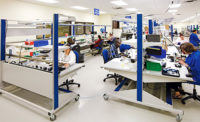Many assembly lines are currently running much slower than this time last year. As a result, there’s a lot more idle time on plant floors these days. Keeping employees busy is crucial to keep workplace morale and productivity high, according to a recent study conducted by Watson Wyatt Worldwide Inc. (Arlington, VA), a leading global consulting firm.
“When employees are highly engaged, their companies enjoy 26 percent higher employee productivity, have lower turnover risk and are more likely to attract top talent,” says Ilene Gochman, global practice leader for organization effectiveness at Watson Wyatt. “Their companies have also earned 13 percent greater total returns to shareholders over the last five years.”
According to Watson Wyatt’s WorkUSA study, highly engaged employees are twice as likely as their less engaged peers to be top performers. They also miss 20 percent fewer days of work and three-quarters of them exceed expectations in their performance reviews. Additionally, highly engaged workers tend to be more supportive of organizational change initiatives and resilient in the face of change.
“Keeping workers productive is always a daunting challenge,” says Gochman. “However, it’s even more crucial in this type of economic environment when organizations are striving to do more with less and employees are paying closer attention.
“There is no ‘one-size-fits-all’ approach to employee engagement,” adds Gochman. “Segmenting the workforce and tailoring communication, performance management programs and other resources to specific employee groups is the most effective way to engage workers. Improving employee engagement will help drive business results in the long run by improving employee commitment to corporate goals and generating exceptional individual performance and productivity.”
Gochman suggests the following tips:
-
Capitalize on engageable moments. An “engageable moment” is a critical juncture for maintaining and building engagement. It might occur when an organization goes through particularly challenging economic times. According to Gochman, engagement starts off high among new employees, but tapers through careers-average employee engagement drops by 9 percent in the first year alone. Almost three-quarters (71 percent) of employees on the job for less than six months claim that they are motivated to do their best work every day. This number drops to 57 percent after six months. “While some decline is inevitable, companies that identify and take action around engageable moments can minimize or potentially even reverse the decline,” claims Gochman.
-
Demonstrate strong leadership and clear direction. When times are difficult, employees want to know about their organization’s specific plans and progress. “Decisive action, backed by clearly articulated rationale, can build support for corporate initiatives, particularly when individual performance objectives and rewards are tied to corporate objectives,” says Gochman.
-
Use effective communication. Effective communication from senior management directly connects employees to the purpose of the organization. “This is particularly important in a challenging economy, when employees are anxious to learn the rationale behind decisions,” says Gochman. “Reviewing communication processes to ensure that information flows vertically, as well as horizontally, throughout the organization is an important step to employee engagement.”
-
Emphasize customer focus. In difficult times, employees are aware that job security is strengthened by satisfied customers. “Emphasizing customer satisfaction keeps employees from being too internally focused and provides a common direction to move the organization forward,” explains Gochman.
-
Institute a system of equitable rewards. While it may be necessary to cut back on rewards, organizations need to understand which reward programs are most important to engage their critical employee segments. “Changes to rewards need to be communicated in a way that is consistent with delivering on the employment ‘deal,’” Gochman points out. “Employees who indicate their organization effectively delivers on the employment deal are 20 times as likely to be highly engaged and 50 percent more likely to be top performers.”
- Invest in the core. The key to driving productivity gains is increasing engagement among core contributors, who represent 60 percent of the typical workforce. According to Gochman, highly engaged employees are already working at or near their peak, but are often limited by their less engaged co-workers. Focusing on core contributors can improve both groups’ productivity.

